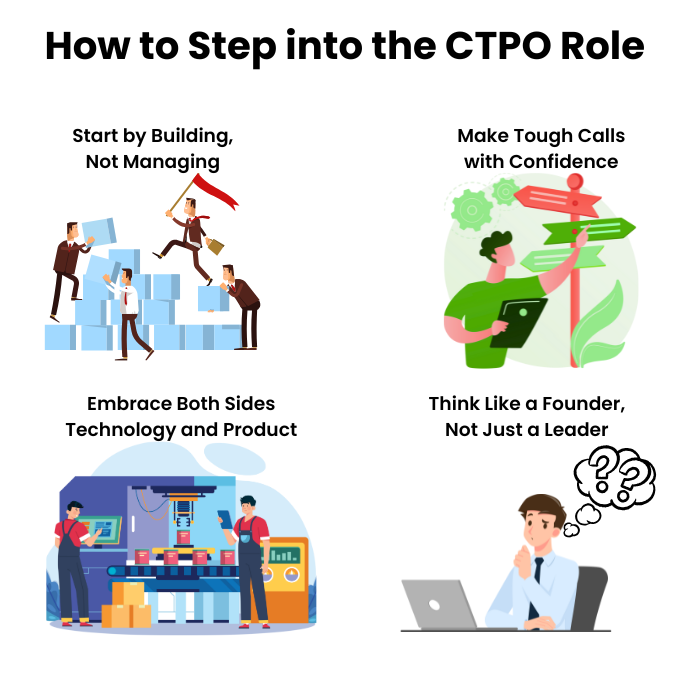As businesses push for faster innovation, the lines between technology and product are blurring. More companies are merging the CTO and CPO roles into one: the Chief Technology and Product Officer (CTPO).
In a recent podcast, Ofer Shterling, CTO at Amberflow.io, shared his journey into this role. With experience at Amazon, Microsoft, and Stripe, he joined a startup as a founding engineer. Over time, his responsibilities expanded beyond engineering to shaping product strategy, making him a natural fit for CTPO.
For startups, combining these roles streamlines decision-making and ensures technical execution aligns with product vision. But it also comes with challenges—balancing both requires tough choices and a deep understanding of customer needs.
So, is the CTPO model the future of tech leadership or just a temporary fix for smaller companies? Let’s dive in.
Understanding the Rise of the Chief Technology and Product Officer (CTPO) Role
The Evolution of the CTPO Role
The Chief Technology and Product Officer (CTPO) role is becoming more common as startups look for faster decision-making and better alignment between technology and product. In this section, we’ll explore why companies are merging these roles, the benefits of a CTPO, and insights from Ofer Shterling on transitioning into this position.
The Traditional Divide Between CTO and CPO
For years, the Chief Technology Officer (CTO) and Chief Product Officer (CPO) operated in separate lanes. The CTO focused on engineering—building scalable systems, managing technical teams, and ensuring smooth operations. The CPO, on the other hand, shaped the product vision—defining user needs, prioritizing features, and aligning development with business goals.
But as businesses push for faster innovation, this traditional split is becoming less practical. In startups especially, the gap between technology and product is too small to justify two separate leadership roles. Instead, many companies are merging them into a single Chief Technology and Product Officer (CTPO), ensuring one leader oversees both strategy and execution.
Why the CTPO Role Is Gaining Popularity
So, why are more companies making this shift? According to Ofer Shterling, the CTPO model solves a key challenge—aligning product vision with technical execution. In early-stage startups, where every decision impacts growth, having one person lead both areas eliminates back-and-forth delays and ensures a clear, unified strategy.
- Faster Decision-Making: With one person overseeing both technology and product, there’s no bottleneck between vision and execution.
- Stronger Synergy: The person who builds the product also understands its business impact, leading to better prioritization.
- Cost Efficiency: Startups operate on tight budgets, and hiring separate executives for product and tech isn’t always feasible.
For Ofer, stepping into this role wasn’t about chasing a title—it was about necessity. When he joined Amberflow.io, the product concept was still vague. The company had an idea—usage-based pricing—but lacked the details. Since Ofer was already leading development, it made sense for him to shape the product strategy as well. This hands-on approach allowed him to refine the idea, build the right features, and turn vision into reality without unnecessary delays.
How to Transition into the CTPO Role—Guest Insights

Ofer didn’t plan to become a CTPO—he evolved into the role. His journey offers valuable lessons for anyone considering this path.
- Start by Building, Not Managing
- Ofer joined Amberflow.io as a founding engineer, focused on solving technical problems. His deep involvement in early product decisions naturally expanded his role.
- Before thinking about leadership titles, focus on understanding the product’s core problem and how technology can solve it.
- Embrace Both Sides—Technology and Product
- A CTPO needs to think beyond code. Ofer spent time researching customer needs, market gaps, and pricing challenges before designing solutions.
- If you’re a CTO, get involved in product decisions. If you’re a CPO, learn the technical side. The more you understand both, the more effective you’ll be.
- Make Tough Calls with Confidence
- A CTPO has to cut features, prioritize resources, and balance business needs with technical realities. Ofer describes the role as feeling like a butcher—always deciding what stays and what goes.
- The key is focusing on what moves the needle. Not every idea can make it into production, and that’s okay.
- Think Like a Founder, Not Just a Leader
- In a startup, every decision impacts survival. Ofer stresses that leading both product and technology requires a builder’s mindset—someone who isn’t just delegating but actively shaping the company’s future.
So, if you’re considering a CTPO role, ask yourself—do you enjoy both building and strategizing? Can you handle the weight of technology and product decisions? If the answer is yes, this could be the next step in your career.
The Responsibilities and Challenges of a CTPO
Leading both technology and product sounds efficient, but it comes with high expectations. A CTPO must ensure that product ideas are both innovative and technically feasible, while also making tough calls on priorities. Ofer Shterling shares how he balances these responsibilities and the challenges that come with the role.
Key Responsibilities of a CTPO
A CTPO carries the weight of both technology and product development, making it a highly demanding role. Ofer Shterling shared how he manages this dual responsibility at Amberflow.io to keep innovation and execution aligned.
- Ensuring Product Vision Matches Technical Feasibility – A great idea is worthless if it can’t be built efficiently. Ofer plays a key role in defining product direction while ensuring the technology can support it without overcomplicating development.
- Prototyping Before Full Execution – Instead of jumping straight into development, Ofer tests ideas through prototypes and early iterations. This minimizes wasted effort and allows the team to refine the concept before committing resources.
- Leading Project Initiation – Every major feature or product improvement starts with him. He helps shape the vision, outline technical requirements, and set priorities to keep the company focused on high-impact developments.
At an early-stage startup, this hands-on approach keeps product and technology perfectly aligned, ensuring the company moves quickly without losing direction.
Biggest Challenges of a CTPO
While the CTPO model brings efficiency, it also comes with hard trade-offs. Ofer describes the role as feeling like a butcher—constantly deciding what stays and what goes to keep the company moving forward.
- Prioritizing What Matters Most – With limited time and resources, not every feature can be built. Ofer must decide which initiatives move the company forward and which ideas, no matter how exciting, need to be cut.
- Managing Short-Term Execution vs. Long-Term Vision – Startups need quick wins, but they also need a strong long-term product strategy. Balancing both requires tough decisions on when to take shortcuts and when to build for the future.
- Scaling the Role as the Company Grows – A CTPO works well in early stages, but as a company expands, it becomes harder for one person to handle both responsibilities. Ofer acknowledges that at some point, he may need to hand off product leadership to a dedicated CPO to keep up with growth.
For now, the CTPO model works at Amberflow.io because of its agility and focus. But as the company scales, will this combined role remain effective?
Lessons Learned and Advice for Aspiring CTPOs
Holding both technology and product leadership in a growing company isn’t just about efficiency—it’s about balancing vision, execution, and leadership. Ofer Shterling shares key lessons from his experience as a CTPO and when it might be time to separate the roles.
Key Takeaways from Holding Both CTO and CPO Titles
Being a CTPO is more than managing teams—it’s about understanding the bigger picture and leading with a mix of passion, compassion, and clarity.
- Passion Fuels Innovation – Ofer has always loved building things. His transition into product leadership wasn’t planned; it came from a deep desire to create and improve. If you’re aiming for this role, love what you build, not just the code behind it.
- Compassion Drives Better Products – A strong technical system means nothing if it doesn’t solve a real problem. Ofer stresses the importance of deeply understanding customer pain points. The best CTPOs don’t just build—they listen, analyze, and create solutions that matter.
- Clarity Keeps Everything on Track – When overseeing both technology and product, tough decisions are constant. Ofer compares the role to that of a butcher—you have to cut unnecessary features, prioritize what drives value, and balance long-term vision with immediate goals.
For early-stage startups, this hands-on approach can be a game-changer. But what happens as a company scales?
When to Consider a Separate CPO Role
While the CTPO model works in the beginning, there comes a point where splitting the roles makes sense. Ofer knows that growth changes everything—and at some stage, companies need dedicated leadership for both product and technology.
- Too Many Moving Parts – As a startup expands, product complexity increases. If product vision starts pulling in one direction and technology in another, it may be time for separate roles.
- Scaling Requires Focus – A CTPO works well when a company is small and agile. But at 100+ employees, balancing both areas can slow things down rather than speeding them up.
- Leadership Gaps Start to Show – If technical teams need more hands-on engineering leadership while product teams demand more market focus, it’s a clear sign that it’s time to bring in a dedicated CPO.
For now, Ofer enjoys wearing both hats. But he knows that change is inevitable, and when the time comes, he’ll adapt. So, will the CTPO model become a long-term trend, or will companies eventually separate these roles as they grow? Let’s look at where the industry is headed next.
Future of the CTPO Role in the Tech Industry

The Chief Technology and Product Officer (CTPO) role is gaining traction, especially in fast-moving startups. But is this a long-term shift or just a temporary solution for early-stage companies? Ofer Shterling shared his thoughts on where this role is headed and the challenges it may face as companies grow.
Will More Companies Adopt the CTPO Model?
Startups and innovation-driven companies are drawn to the CTPO model because it eliminates silos between technology and product. Instead of two leaders debating priorities, a single executive drives both vision and execution.
- Faster Innovation – In the early stages, companies need quick decision-making and seamless execution. The CTPO model helps avoid delays that happen when tech and product teams are misaligned.
- Stronger Product-Technology Synergy – Since the CTPO understands both engineering and products, they can prioritize features that make the most impact without overcomplicating development.
- Cost Efficiency – Hiring separate leaders for technology and product is expensive. Start-ups with lean budgets find the CTPO role a practical solution until they scale.
But I didn’t stop there—let’s talk about the challenges that come with this combined role, especially as companies grow.
Potential Challenges for CTPOs in Larger Organizations
While the CTPO model works well in startups, scalability is a different story. As teams expand, the workload increases, making it harder for one person to manage both technology and product effectively.
- Too Many Responsibilities – A CTPO in a 10-person startup can oversee everything. But at 100+ employees, the responsibilities become overwhelming. Managing a growing engineering team, product vision, and customer needs all at once leads to bottlenecks.
- Risk of Burnout – The demands of running both product and technology can stretch even the best leaders thin. Decision fatigue becomes real when one person is constantly juggling technical challenges, product roadmaps, and business goals.
- Scaling Requires Specialization – As companies grow, product development and engineering require more focused leadership. At some point, splitting the roles allows each team to get the attention they need.
Ofer acknowledges that at Amberflow.io, the CTPO model works for now, but as the company scales, it will need to adapt. So, will the future favor combined leadership, or will companies eventually return to separate CTO and CPO roles? Only time will tell.
Conclusion
The CTPO role is more than just a trend—it’s a response to the need for speed, efficiency, and tighter product-technology alignment in startups. Ofer Sterling’s experience shows that when a company is small, a single leader overseeing both functions can drive innovation and eliminate roadblocks. However, as the company scales, the demands on both product and engineering increase, making specialization unavoidable.
The real takeaway? Being a CTPO isn’t just about managing two roles—it’s about having a builder’s mindset. The best CTPOs don’t just oversee teams; they deeply understand customer pain points, make tough prioritization calls, and ensure technical execution serves business goals. Whether the role remains long-term or evolves back into separate leadership positions, one thing is clear: Success in this role requires a unique mix of technical expertise, product vision, and strategic decision-making.
So, is the CTPO model the future of tech leadership, or just a phase for early-stage startups? It depends on the company, its growth, and the leader’s ability to balance both worlds. What do you think?




